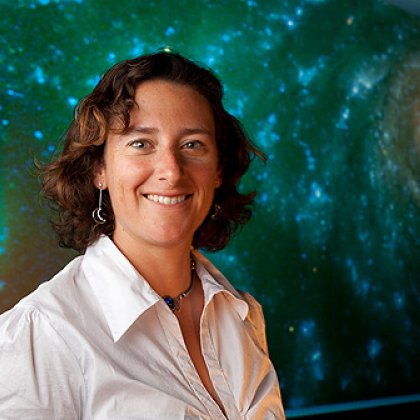
An astrophysicist from The University of Queensland’s School of Mathematics and Physics has been awarded the prestigious L’Oréal Women in Science Award for 2009.
Dr Tamara Davis has been acknowledged for her contribution to astrophysics through her hunt for dark energy.
She aims to continue the hunt using a new Australian telescope that has grown out of the ashes of the 2003 fire that destroyed Mt Stromlo Observatory.
“We know that stars, planets, galaxies and all that we can see makes up just four per cent of the Universe,” Dr Davis said.
“About 23 per cent is dark matter. The balance is thought to be dark energy, which we know very little about.”
Dr Davis hopes to use the Australian National University’s new telescope “Skymapper” at the Mt Stromlo Observatory to track the movement of supernovae to understand dark energy.
“Supernovae are extremely bright stellar explosions,” Dr Davis said.
“Because we know how bright they are we can use them as ‘standard candles’ to accurately measure distance and motion across the Universe.”
The SkyMapper telescope offers some unique opportunities for mapping the Universe that makes her hunt even more exciting.
“SkyMapper takes images that are 25 times larger than the full moon. This allows us to scan the southern sky once every four days,” Dr Davis said.
Until recently, the best telescopes would take a year to cover the same area.
“Using Skymapper allows us to look at a much bigger region of the nearby Universe, rather than zeroing in on single objects or distant galaxies,” she said.
Using the data generated over the next couple of years, Dr Davis hopes to detect invisible dark matter by observing the effects of its gravity on the motion of supernovae.
However, for such an ambitious project, Dr Davis needs an all-star team of scientists, with expertise in various areas from observational analysis to theoretical physics.
Dr Davis plans to use her $20,000 L’Oréal Australia For Women in Science Fellowship to help assemble an international team of scientists to work on this project.
She is no stranger to working with leaders in the field including Nobel Laureate George Smoot, and Shaw & Gruber prize winners Brian Schmidt, Adam Riess and Saul Perlmutter.
A leader in her own right, Dr Davis has written numerous journal articles and reviews, including two in Nature, and two book chapters, that in total have over 1000 citations.
As a team member in the ESSENCE and SDSS supernova surveys, Dr Davis and colleagues have discovered over seven hundred supernovae.
In 2007 Dr Davis led the ESSENCE collaboration in a paper that ruled out two of the leading alternative cosmological models, based on quantum theories of gravity.
This became one of the top-ten most highly-cited astrophysics papers of that year and gained her the Astronomical Society of Australia‘s 2009 Louise Webster Prize.
Now with the Australian team WiggleZ making the largest ever three-dimensional map of the distribution of galaxies in the Universe, Dr Davis is well placed to test new cosmological theories that explain dark energy.
The $20,000 L'ORÉAL Australia For Women in Science Fellowships are awarded annually to three Australian scientists.
2009 Awards were also presented to Zenobia Jacobs, University of Wollongong and Marnie Blewitt, The Walter & Eliza Hall Institute of Medical Research, Melbourne.
For more information on L’Oréal Women in Science Awards, visit http://www.scienceinpublic.com/loreal/. This site also contains video footage of Dr Davis talking about her research and the award.
Media: Dr Tamara Davis can be contacted on 0432 526 989, or tamarad@physics.uq.edu.au
For more information on astrophysics research at UQ, contact Lynelle Ross (07 3346 9935 or l.ross@smp.uq.edu.au).
Image: Tamara Davis, University of Queensland / University of Copenhagen (photo credit: timothyburgess.net)
.jpg)



